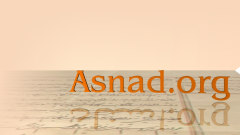How to use this Database
In order to improve this section we need your comments and criticism, so please contact us with any questions you might have under info@asnad.org.
Search
Simple Search
The initial search field offers a full text search in all central data fields, multiple entries are joined automatically. It only looks for full words (> 4 letters) and numbers, truncation is not possible. You can search for concrete years, both hijri and CE, but not for time periods.
Examples:- a valid search is "Muhammad Isfahan", "farman Safavids" or "996"
- invalid search requests are "1012-1056" or "Safav*"
Advanced Search
In addition to the standard full text search, the advanced search allows to look for defined periods of time, both in Islamic and Common Era. The pull-down menus offer direct access to the indices of individuals, place names and subject keywords (which are hyperlinked in the result view). The search can easily be narrowed down to only published or unpublished documents, or to those accompanied by a facsimile or an edition. Search results can be limited to the three pre-defined document categories or the document type (i.e. farman or vaqfnamah). Of special interest might be the possibility to search for whole collections or all documents published in one journal or volume. All fields can be combined freely.
Database
Dates
The date of documents is given according to both Islamic (hijri) and Common Era calendar systems. Unless a document is dated on a specific day (i.e. 6. Jumada II 1214), dates are always defined as intervals. This will allow a concise search for time spans and helps to integrate documents with defective or questionable dating.
Examples:- A decree dated Rabi' I 1020 is interpreted as "1020, 1. Rabi' I - 1020, 30.Rabi' I (14.5.1611 - 12.6.1611)"
- An undated letter from Shah 'Abbas II would be dated according to his reign or other circumstantial evidence, with further information in the notes.
Document category and type
All documents are divided into three major categories:- "imperial and royal decrees" includes farmans and raqams issued by state chanceries
- "private documents" includes charters, contracts and deeds attested by shari'a courts
- "letters and corrspondence"
Content and Index Entries
The content of a document is intended as a short summary. Further information is included in the index entries according to individuals, places and subject matter.
Files and Images
Images are shown in the preview box. Document entries with several images carry a link to a thumbnail gallery from where you can change the preview. For full-scale high-resolution images simply click on the preview or right-click in order to download the image. Some image files are rather large (>5 MB).
In order to view or download the edition included in pdf-format follow the link "Download Edition".
Transliteration and Bibliography
The system of transliteration follows that of the Library of Congress without diacritic signs. This choice is not based on personal preferences, but operates on the assumption that a database with information on publications should use library standards as a reliable guideline.
So if you can not find something you are looking for, first make sure your transliteration is correct.
Note that the Persian ezafe is -i or -yi if so pronounced (i.e. "shishah-yi 'umr-i Iran"). The letter 'ayn is represented by simple apostrophe and absolutely needs to be inserted: thus 'Abbas, not Abbas. Initial and final hamzah in words of Arabic origin (i.e. vuzara) is omitted, but is represented by apostrophe in the middle of a word. To give some examples:
- "Tihran", not "Tehran"
- "namah", not "namih" or "name"
- "Khvajah", not "Khwajih" and "vaqf", not "waqf"
- "Aminullah", not "Amin-allah"; "Fath-'Ali Khan", not "Fathali Khan"
Users who categorically abhor the idea of transliteration are kindly asked to exercise some patience until the Persian version of the database is ready which will allow search options in Arabic script.
Finally, the citation system employed follows MLA-style. Once again not because American standards are naturally superior to others. There is, however, a good manual around and it is an acknowledged system that should be familiar to most researchers.



